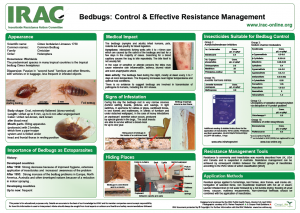Cimex lectularius
Cimex lectulariusBody shape: Oval, extremely flattened (dorso-ventral)
Length: Unfed up to 6 mm, up to 9 mm after engorgement
Color: Unfed red-brown, dark brown after blood meal
Mouth parts: Biting apparatus (proboscis) with 2 bristles which form a pipe-in-pipe system and is folded under the head and frontal thorax in resting position
Bed Bugs resistance profile
Multiple resistance mechanisms, including penetration resistance through thickening or remodelling of the cuticle, metabolic resistance by increased activities of detoxification enzymes (e.g. cytochrome P450 monooxygenases and esterases), and knockdown resistance by kdr mutations, have been experimentally identified as conferring insecticide resistance in bed bugs. Other candidate resistance mechanisms, including behavioral resistance, some types of physiological resistance (e.g. increasing activities of esterases by point mutations, glutathione S-transferase, target site insensitivity including altered AChEs, GABA receptor insensitivity and altered nAChRs), symbiont-mediated resistance and other potential, yet undiscovered mechanisms may exist. (Dang K, et al. 2017)
| Species | Distribution | Chemical class | Mechanisms |
|---|---|---|---|
| () |
